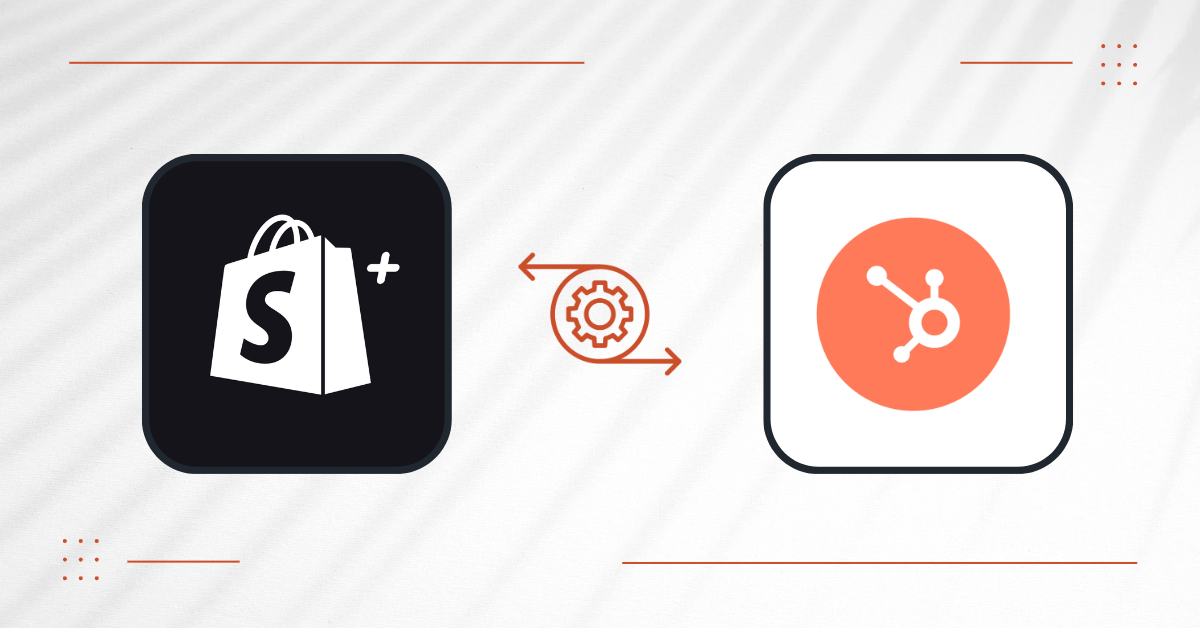As an eCommerce business owner, you need to make sure that your online shopping website is running efficiently to maximize your profits. Shopify is a leading eCommerce platform, and HubSpot is a leading CRM platform.
And Shopify HubSpot integration is the process of connecting your Shopify store with HubSpot, a marketing automation and CRM platform.
When you integrate Shopify and HubSpot, you can automate your marketing campaigns, track your customers’ journey, and personalize your customer’s experience. You can also leverage HubSpot’s CRM capabilities to manage your customer relationships, track sales, and monitor your revenue.
Now let’s discuss in detail the best practices for using Shopify and HubSpot together and how to set up Shopify HubSpot integration for maximum efficiency.
How to Set Up Shopify HubSpot Integration
There are several ways to integrate the Shopify platform and HubSpot. Here are three popular methods:
Option A. Shopify HubSpot Integration Using Middleware Like DCKAP Integrator
There are many third-party integration platforms available that can help businesses set up HubSpot Shopify integration. Some of the popular apps include Zapier, Jitterbit Automate.io, Cleo and DCKAP Integrator.
DCKAP Integrator is a leading cloud-based iPaaS (Integration Platform as a Service) that simplifies the integration process between various platforms, including Shopify and HubSpot.
Here’s how you can set up the HubSpot Shopify integration with DCKAP Integrator:
Step 1
You first need to register and set up an account. The registration process requires you to provide your first and last name and email address. Once you register, you will receive an activation link in your email that you need to click on to activate your account.
Step 2
After activating your account, you will be redirected to the DCKAP Integrator Dashboard, which provides you with high-level insights about different metrics of projects managed under your user account.
The dashboard includes various project metrics, such as the number of API calls made to other systems, the percentage of records processed successfully, the number of new customers and orders, and a list of all projects that you have access to.
Step 3
To integrate Shopify and HubSpot, you need to create a project in DCKAP Integrator, which consists of integration units called Pipes.
These units are connected to each other to enable customer and sales data transfer between Shopify Plus and HubSpot. You can create new integration pipes and schedule data synchronization using DCKAP Integrator’s drag-and-drop feature.
Step 4
To manage your DCKAP Integrator account, you can access the account settings, change your password, and view/edit your profile.
You can also switch accounts to access and manage projects that you have been given access to. The Projects page is considered the epicenter of the integration process, where you can create, edit, and view all the projects you have access to.
The Projects page consists of a list of all the projects you have created or have been given access to. You can manage a project by navigating to the Project space, where you can access, edit, and create different aspects (Integrations, Credentials, Flows, etc.) of the project.
Overall, DCKAP Integrator simplifies the integration process between Shopify and HubSpot and makes it easy to manage and monitor integration transactions.
Option B. Shopify HubSpot Integration Using Shopify Plugins
Integrating Shopify and HubSpot can help streamline your ecommerce operations and boost your marketing efforts. One way to integrate these two platforms is by using Shopify plugins. Here’s how you can do it:
1. Choose a Shopify plugin
There are several Shopify plugins available that can help you integrate HubSpot. Some popular options include HubSpot for Shopify, HubSpot Connector, and HubSpot Ecommerce Bridge.
2. Install the plugin
Once you have chosen a plugin, install it on your Shopify store. Follow the instructions provided by the plugin developer to install it correctly.
3. Connect your HubSpot account
After installing the plugin, you will need to connect your HubSpot account to your Shopify store. The plugin should provide you with clear instructions on how to do this.
4. Configure the integration
Once the plugin is installed and your HubSpot account is connected, you can start configuring the integration. This may include setting up workflows, creating custom fields, and mapping your Shopify data and HubSpot data.
5. Test the integration
Before going live with the integration, it’s important to test it thoroughly to ensure that everything is working correctly. Test different scenarios, such as making a purchase, updating customer information, and tracking order statuses.
6. Launch the integration
Once you’re confident that the integration is working correctly, you can launch it. Make sure to monitor it closely in the first few weeks to ensure that it’s functioning as expected.
Possible Integration Difficulties
However, before you integrate, here are some potential demerits that you need to know. Shopify plugins for HubSpot have potential demerits to consider, including limited functionality, complexity, cost, security risks, and compatibility issues.
The plugins may not offer all the features you need, can be time-consuming to set up, come with additional costs, pose security vulnerabilities, and cause compatibility issues between the two software systems.
Recommended Reading: The HubSpot Epicor Eclipse Integration Guide
Option B. Shopify HubSpot Integration Using APIs
If you’re comfortable with coding, you can use APIs to integrate Shopify and HubSpot. Here’s how to set up Shopify HubSpot integration using APIs:
1. Create a HubSpot Account
If you don’t already have a HubSpot account, you will need to create one. You can do this by going to the HubSpot website and signing up for a free account.
2. Generate API keys in HubSpot
Once you have a HubSpot account, you need to generate API keys. Go to the HubSpot API page and create a new API key. You will need this key later to connect Shopify with HubSpot.
3. Create a Shopify App
In order to use the Shopify API, you will need to create a Shopify app. Go to the Shopify Partners website and create a new app. You will need to provide information about your app and configure its settings.
4. Connect Shopify with HubSpot
Once you have created your Shopify app and generated your HubSpot API keys, you can connect Shopify with HubSpot. In the Shopify app settings, go to the “App setup” section and enter your HubSpot API key. This will allow Shopify to communicate with HubSpot.
5. Set Up Real-Time Data Syncing
After you have connected Shopify with HubSpot, you need to set up data syncing. This will allow data to be automatically transferred between the two platforms. You can use the HubSpot API to sync customer data, order data, shopping cart data, and product data.
6. Customize Your Integration
Finally, you can customize your integration to meet your specific needs. You can use the HubSpot API to create custom properties, workflows, and reports. This will help you get the most out of your integration and improve your business operations.
Possible Integration Difficulties:
Integrating Shopify and HubSpot using APIs can be challenging due to technical complexity, potential data sync errors, additional costs, security risks, ongoing maintenance and support, and limitations on data transfer.
It requires expertise and knowledge of both platforms to set up and maintain the integration accurately, which can be costly and pose a security risk.
Moreover, API integrations require regular maintenance and updates to ensure they are functioning correctly, and they may have limitations on the types of data that can be transferred between platforms.
Relevant Reading: Shopify Epicor Connector: How The P21 Integration Works
Automating Business Processes With Shopify HubSpot Integration
Shopify HubSpot integration can help automate your business processes by streamlining data flow between your Shopify eCommerce store and your HubSpot CRM platform. With this integration, you can:
Sync Customer Data
By integrating Shopify with HubSpot, you can sync customer data from your Shopify store to your HubSpot CRM automatically. This can include customer contact information, order history, and more. By having all of this data in one place, you can gain a better understanding of your customers and tailor your marketing efforts accordingly.
Automate Marketing Workflows
You can create automated workflows in HubSpot that trigger based on customer behavior, such as abandoned carts or purchases. This can help you nurture leads and drive more sales.
Create Targeted Campaigns
By combining data from Shopify and HubSpot, you can create targeted marketing campaigns that are more likely to resonate with your audience. For example, you can create a campaign that targets customers who have purchased a certain product in the past.
Personalize Customer Interactions
Excellent customer support is what helps you stand outside. With the data you collect from Shopify and HubSpot, you can personalize your interactions with customers. For example, you can send personalized emails based on their order history or recommend products based on their browsing behavior.
Track Performance
With the integration, you can track the performance of your marketing campaigns and see how they impact your sales. This can help you make data-driven decisions and optimize your marketing efforts.
Similar Reading: Shopify eCommerce integration
Success Stories: Integrations for Shopify and for HubSpot
Steel and Pipes- Shopify & P21 Extension
Steel and Pipes, a steel market provider in Puerto Rico and the Caribbean, was facing challenges with manual data entry and data assessment in their P21 ERP and Shopify online storefront. They had a large product database and were unable to customize products as per business demands and customer requests, making it complicated for customers to explore products.
With the help of DCKAP Integrator Connector, Steel and Pipes achieved seamless Shopify integration by connecting their ERP and eCommerce storefront, allowing for smooth workflow of product data, inventory, order processing, and order fulfillment.
The integration took only 2 weeks to set up, providing Steel and Pipes with the liberty to customize their product data and showcase their products without any worry of scattered data in the backend. Integration proved to be the innovation that placed Steel and Pipes on a high pedestal.
Read the complete case study here.
Get Started with Your Shopify HubSpot Integration
Integrating Shopify with HubSpot can provide numerous benefits for your eCommerce company, including streamlined workflows, lead generation, improved customer engagement, and better data insights.
Reach out to our integration experts to help you get started with this integration seamlessly. By leveraging the right integration solution, you can unlock the full potential of your Shopify store and achieve greater success in your online business. Contact the DCKAP Integrator support team today to learn more about the benefits of integrating your ecommerce platform and CRM.
Contents




